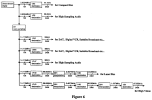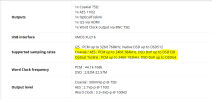Just to be precise, the corner frequency of 100 kHz is not stated in the
Super Audio CD System Description (commonly known as "Scarlet Book"),
Part 2: Audio Specification, Version 2.0 of March 2004. This standard describes the characteristics of the low pass filter in Annex E,
Audio Signal Recommendations, which is labelled
Informative, contrary to Annex D
Audio Signal Requirements, which is described as
Normative.
The recommendations made in the Scarlet Book are :
"
To protect analog amplifiers and loudspeakers, it is recommended that a Super Audio CD player
contain at its output an analog low pass filter with a cut-off frequency of maximum 50 kHz and a slope
of minimum 30 dB/Oct. For use with wide-band audio equipment, filters with a cut-off frequency of
over 50 kHz can be used." (Annex E2)
From the frequency response plot of the DCD-SA1 in SA-CD mode published by the
German magazine Stereoplay, the level is down 3 dB at about 50/55 kHz. So this Denon
seems to follow the recommendation of the Scarlet book as far as the corner frequency of the output filter is concerned.



